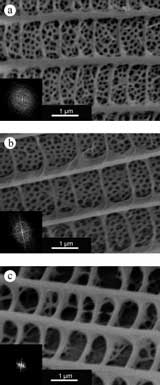
|
Most
male lycaenid butterflies display iridescent blues. In populations living
at altitudes above 2000 meters, however, they've forsaken their Technicolor
suits for a drab brown. A new study suggests that the dull coloring has a
purpose more important than titillating potential mates: It helps the highlanders
survive the mountain chill.
 |
Holey wings. Natural photonic crystals give butterfly wings iridescent
blue (top) or blue-violet (middle) color, but they're absent in brown-winged
butterflies (bottom).
CREDIT: L. P. BIRO ET AL., PHYSICAL REVIEW E (FEBRUARY 2003) |
Butterflies
rely solely on the sun's energy to bring their bodies up to working temperature,
so heat management is crucial. That's why butterflies spread their wings
and soak up as many rays as possible before starting their day. Biologists
hypothesized that the brown lycaenid males were somehow able to capture the
sun's radiation more efficiently, but they lacked conclusive evidence.
Scientists now report in the February issue of Physical Review E
that they have found such evidence in the tiny scales that give the wings
their color. In blue butterflies, these are made of nearly clear material.
An array of submicrometer-sized holes arranged in a particular pattern reflect
blue light, the scientists discovered by examining the wings with an electron
microscope. This arrangement is similar to that found in so-called photonic
crystals, which engineers use to trap and manipulate photons. No such holes
were found in the scales of their brown brethren, says co-author Jean-Pol
Vigneron, a physicist at the University Notre-Dame de la Paix in Namur, Belgium.
Spectroscopic measurements demonstrated that more light bounced off the blue
compared to the brown butterfly's scales, giving the lowlander its flashy
looks and--in case of the highlander--letting much needed energy pass through
to the wing below. Thermal analysis confirmed that under strong artificial
light, brown wings soak up much more heat than blue ones.
The blue butterflies'
scales might be a compromise, says Andrew Parker, a biologist at Oxford University,
United Kingdom. The brown butterflies can survive the cold, but lack the
flashy colors that presumably help attract mates. The blues look sharp but
are confined to living in moderate climates. Parker says that scales reflecting
red light may have all the advantages: color and good heating properties
because they let more energetic blue light pass. But the photonic crystals
would have to be considerably enlarged. For a red butterfly, "weight may
become a problem," speculates Parker.
--DANIEL BACHTOLD
Related site
Jean-Pol Vigneron's site (in French)
|

![]() Copyright © 2003 by the American Association for the Advancement of Science.
Copyright © 2003 by the American Association for the Advancement of Science.